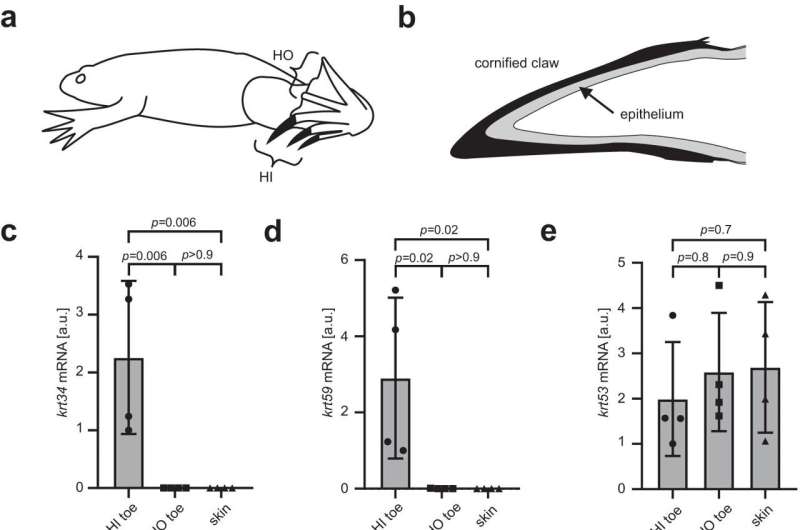This article has been reviewed according to Science X's editorial process and policies. Editors have highlighted the following attributes while ensuring the content's credibility:
fact-checked
trusted source
proofread
Genetic basis for the evolution of hair discovered in the clawed frog

The development of hair was of central importance for the evolution of mammals and, thus, also of humans. However, the evolutionary origin of the genetic program of hair was previously unknown. An international research team led by Leopold Eckhart from MedUni Vienna has now been able to show that important hair components and their genetic control have already evolved in amphibians.
Human hair, therefore, shows unexpected similarities to the claws of clawed frogs. The results were published in Nature Communications.
In order to investigate the evolution of skin appendages, which include human hair and nails, the MedUni Vienna research team, in collaboration with the University of Ghent (Belgium), used the tropical clawed frog (Xenopus tropicalis) as an experimental model.
The study revealed that the cornified claws of Xenopus frogs consist of special proteins (keratins) that are very similar to the main components of mammalian hair and nails. The formation of these keratins was found to be controlled by a specific gene, Hoxc13, in both humans and frogs.
"It is known that patients with mutations in the Hoxc13 gene have defects in the growth of hair and nails. In our study, we were able to block the formation of claws in the clawed frog by switching off this gene," reports Leopold Eckhart from MedUni Vienna's Department of Dermatology. These results indicate that the genetic program for the development of keratinized claws originated in a common ancestor of humans and frogs.
"During the evolution of mammals, the program of claw formation was modified for the development of hair," says Eckhart.
Important research question clarified
The evolution of terrestrial vertebrates is characterized by the appearance of an effective skin barrier against water loss in a dry environment and by the development of hard, keratinized skin appendages such as claws, scales, feathers, and hair, which are crucial for catching prey, protection, supporting special types of locomotion and thermal insulation.
The evolution of skin appendages is, therefore, an important research question. The findings from the project contribute to clarifying the evolutionary origin of keratinized skin appendages and also help to understand the regulation of hair in humans better. "Our publication will stimulate further exciting studies in basic and preclinical research," concludes Eckhart.
More information: Marjolein Carron et al, Evolutionary origin of Hoxc13-dependent skin appendages in amphibians, Nature Communications (2024). DOI: 10.1038/s41467-024-46373-x
Provided by Medical University of Vienna





















